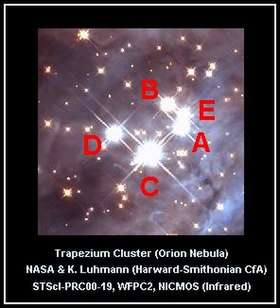獵戶座θ1C
外观
| 观测资料 历元 J2000 | |
|---|---|
| 星座 | 猎户座 |
| 星官 | |
| 赤经 | 05h 35m 16.46375s[1] |
| 赤纬 | −05° 23′ 22.8486″[1] |
| 视星等(V) | 5.13[2] |
| 特性 | |
| 光谱分类 | O6Vp + B0V[3] |
| U−B 色指数 | −0.95[2] |
| B−V 色指数 | +0.02[2] |
| 变星类型 | suspected[4] |
| 天体测定 | |
| 径向速度 (Rv) | +23.6 ± 2.0[5] km/s |
| 自行 (μ) | 赤经:−4.13[1] mas/yr 赤纬:6.82[1] mas/yr |
| 视差 (π) | 2.11 ± 0.41[1] mas |
| 距离 | 410 ± 20[6] pc |
| 绝对星等 (MV) | −4.9[7] |
| 详细资料 | |
| C1 | |
| 质量 | 33 ± 5[3] M☉ |
| 半径 | 10.6 ± 1.5[7] R☉ |
| 表面重力 (log g) | 4.1[7] |
| 亮度 | 204,000[7] L☉ |
| 温度 | 39,000 ± 1,000[7] K |
| 自转速度 (v sin i) | 24 ± 3[7] km/s |
| 年龄 | 2.5 ± 0.5[7] Myr |
| C2 | |
| 质量 | 11 ± 5[3] M☉ |
| 轨道[6] | |
| 主星 | C1 |
| 伴星 | C2 |
| 绕行周期 (P) | 11.05 ± 0.03 yr |
| 半长轴 (a) | 40.00 ± 3.00" |
| 偏心率 (e) | 0.534 ± 0.050 |
| 倾斜角 (i) | 100.7 ± 1.0° |
| 升交点黄经 (Ω) | 25.3 ± 1.5° |
| 近心点幅角 (ω) (secondary) | 290.9 ± 2.5° |
| 其他命名 | |
| 参考数据库 | |
| SIMBAD | 资料 |
猎户座θ1C(θ1 Orionis C)是位于猎户座星云内的疏散星团,猎户四边形星团中的一员。这颗恒星C是在这个星团心脏4颗中质量最大也最亮的一颗。它是O型主序星,并且有几颗B型主序星的伴星。它的高光度和距离(大约1,500光年)使他的视星等为5.1等。
猎户座θ1包含数颗恒星,主要是由梯形星团彼此相距约1弧分的4颗恒星组成。猎户座θ2是距离更远的一个恒星集团,有三颗主要的恒星和几颗微弱的伴星,与猎户座θ1相距1-2弧。
猎户座θ1C本身就是两颗大质量恒星,C1和C2,再加上一颗看似逃逸,但非常靠近的微弱伴星的联星系统[8]。
猎户座θ1C1负责生成大部分的紫外线,并使猎户座大星云缓慢的电离(或许是光致蒸发)。这些紫外线也是猎户座星云被照亮和发光的主要原因。这颗恒星吹出强烈的恒星风,强度超过太阳风数十万倍,气体向外吹送的速度在1,000 km/s。
参考资料
[编辑]- ^ 1.0 1.1 1.2 1.3 1.4 van Leeuwen, F., Validation of the new Hipparcos reduction, Astronomy and Astrophysics, November 2007, 474 (2): 653–664, Bibcode:2007A&A...474..653V, arXiv:0708.1752
 , doi:10.1051/0004-6361:20078357
, doi:10.1051/0004-6361:20078357
- ^ 2.0 2.1 2.2 Ducati, J. R. VizieR Online Data Catalog: Catalogue of Stellar Photometry in Johnson's 11-color system. CDS/ADC Collection of Electronic Catalogues. 2002, 2237: 0. Bibcode:2002yCat.2237....0D.
- ^ 3.0 3.1 3.2 Balega, Yu. Yu.; Chentsov, E. L.; Leushin, V. V.; Rzaev, A. Kh.; Weigelt, G. Young massive binary θ 1 OriC: Radial velocities of components. Astrophysical Bulletin. 2014, 69 (1): 46–57. Bibcode:2014AstBu..69...46B. ISSN 1990-3413. doi:10.1134/S1990341314010052.
- ^ Samus, N. N.; Durlevich, O. V.; et al. VizieR Online Data Catalog: General Catalogue of Variable Stars (Samus+ 2007–2013). VizieR On-line Data Catalog: B/gcvs. Originally published in: 2009yCat....102025S. 2009, 1: 02025. Bibcode:2009yCat....102025S.
- ^ Olivares, J.; Sánchez, L. J.; Ruelas-Mayorga, A.; Allen, C.; Costero, R.; Poveda, A. KINEMATICS OF THE ORION TRAPEZIUM BASED ON DIFFRACTO-ASTROMETRY AND HISTORICAL DATA. The Astronomical Journal. 2013, 146 (5): 106. Bibcode:2013AJ....146..106O. ISSN 0004-6256. arXiv:1310.0769
 . doi:10.1088/0004-6256/146/5/106.
. doi:10.1088/0004-6256/146/5/106.
- ^ 6.0 6.1 Kraus, S.; Weigelt, G.; Balega, Y. Y.; Docobo, J. A.; Hofmann, K.-H.; Preibisch, T.; Schertl, D.; Tamazian, V. S.; Driebe, T.; Ohnaka, K.; Petrov, R.; Schöller, M.; Smith, M. Tracing the young massive high-eccentricity binary system θ1Orionis C through periastron passage. Astronomy and Astrophysics. 2009, 497 (1): 195–207. Bibcode:2009A&A...497..195K. ISSN 0004-6361. arXiv:0902.0365
 . doi:10.1051/0004-6361/200810368.
. doi:10.1051/0004-6361/200810368.
- ^ 7.0 7.1 7.2 7.3 7.4 7.5 7.6 Simón-Díaz, S.; Herrero, A.; Esteban, C.; Najarro, F. Detailed spectroscopic analysis of the Trapezium cluster stars inside the Orion nebula. Astronomy and Astrophysics. 2006, 448 (1): 351–366. Bibcode:2006A&A...448..351S. ISSN 0004-6361. doi:10.1051/0004-6361:20053066.
- ^ Vitrichenko, E. A.; Lehmann, H.; Klochkova, V.; Bychkova, L.; Bychkov, V. Detection of a star escaping from the Orion Trapezium. Astrophysics. 2010, 53 (2): 306–308. Bibcode:2010Ap.....53..306V. ISSN 0571-7256. doi:10.1007/s10511-010-9120-2.

